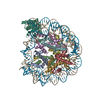+Search query
-Structure paper
| Title | Binding to nucleosome poises human SIRT6 for histone H3 deacetylation. |
|---|---|
| Journal, issue, pages | Elife, Vol. 12, Year 2024 |
| Publish date | Feb 28, 2024 |
 Authors Authors | Ekaterina Smirnova / Emmanuelle Bignon / Patrick Schultz / Gabor Papai / Adam Ben Shem /  |
| PubMed Abstract | Sirtuin 6 (SIRT6) is an NAD-dependent histone H3 deacetylase that is prominently found associated with chromatin, attenuates transcriptionally active promoters and regulates DNA repair, metabolic ...Sirtuin 6 (SIRT6) is an NAD-dependent histone H3 deacetylase that is prominently found associated with chromatin, attenuates transcriptionally active promoters and regulates DNA repair, metabolic homeostasis and lifespan. Unlike other sirtuins, it has low affinity to free histone tails but demonstrates strong binding to nucleosomes. It is poorly understood how SIRT6 docking on nucleosomes stimulates its histone deacetylation activity. Here, we present the structure of human SIRT6 bound to a nucleosome determined by cryogenic electron microscopy. The zinc finger domain of SIRT6 associates tightly with the acidic patch of the nucleosome through multiple arginine anchors. The Rossmann fold domain binds to the terminus of the looser DNA half of the nucleosome, detaching two turns of the DNA from the histone octamer and placing the NAD binding pocket close to the DNA exit site. This domain shows flexibility with respect to the fixed zinc finger and moves with, but also relative to, the unwrapped DNA terminus. We apply molecular dynamics simulations of the histone tails in the nucleosome to show that in this mode of interaction, the active site of SIRT6 is perfectly poised to catalyze deacetylation of the H3 histone tail and that the partial unwrapping of the DNA allows even lysines close to the H3 core to reach the enzyme. |
 External links External links |  Elife / Elife /  PubMed:38415718 / PubMed:38415718 /  PubMed Central PubMed Central |
| Methods | EM (single particle) |
| Resolution | 2.94 - 3.79 Å |
| Structure data |  EMDB-16842: SIRT6 bound nucleosome  EMDB-16843: Nucleosome bound human SIRT6 EMDB-16845: Nucleosome Bound human SIRT6 (composite structure)  EMDB-16861: Sirt6 bound nucleosome - consensus map  EMDB-18497: Human Sirtuin 6 in complex with nucleosome - structure showing H2A tail path |
| Chemicals |  ChemComp-ZN: |
| Source |
|
 Keywords Keywords |  GENE REGULATION / GENE REGULATION /  Transferase / Transferase /  Deacetylase / Histone H3 deacetylation Deacetylase / Histone H3 deacetylation |
 Movie
Movie Controller
Controller Structure viewers
Structure viewers About Yorodumi Papers
About Yorodumi Papers







